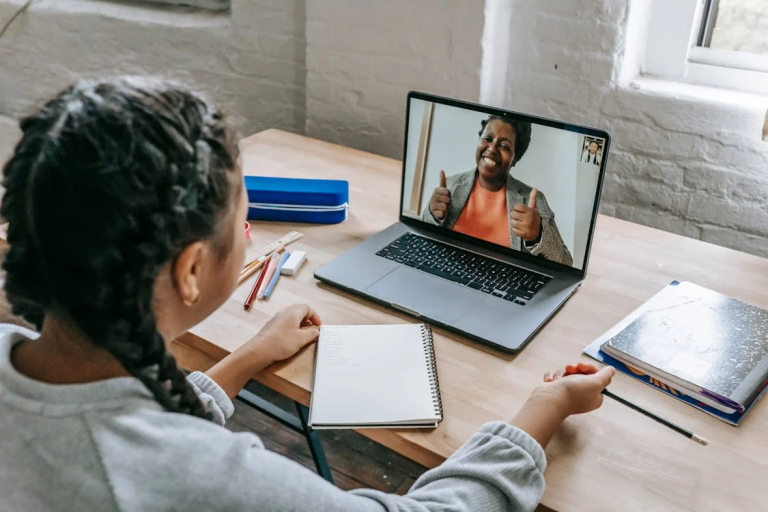Integrating Online School Into Your Child’s Home Learning Routine

The shift to online schooling has redefined education for families worldwide, creating both unprecedented opportunities and unique challenges. Bringing an online school’s program into your child’s home learning routine requires thoughtful planning, a structured environment, and ongoing support.
This approach is all-encompassing, which is best for both the academic pursuits of students as well as their overall well-being. In the following article, we will introduce and discuss practical strategies for smoothly blending the online school experience into your child’s daily life. Using these strategies will help set both you and them on the path towards a balanced, enriching educational experience.
Creating a Dedicated Learning Space

Ergonomic Setup for Improved Focus
A well-organized, ergonomic learning space is highly recommended for maintaining focus and comfort during online school sessions.
Ergonomics refers to how efficient individuals are in their workspace. While the term has been widely used in office spaces to refer to cubicle and private office setups, it is equally important for students learning from home. For the ideal setup, choose a quiet, well-lit area free from distractions where your child can concentrate on their studies.
Make sure the furniture is appropriately sized for your child, with a comfortable chair and desk that will prevent strain and promote good posture. An ergonomic workspace not only improves focus but also reduces the risk of physical discomfort. This will help your child stay engaged and productive. It will be just one less thing to worry about in their transition to online schooling.
Including Interactive Learning Tools
To improve the online learning experience, it’s a good idea to incorporate interactive learning tools into the dedicated space. Make sure the area has a high-quality computer or tablet, high-speed internet connection, and any other supportive accessories like headphones, a webcam, and a printer.
Also, think about using educational software, apps, and online resources that complement the curriculum. Interactive tools like digital whiteboards, educational games, and virtual lab simulations can make learning more interesting and effective.
Developing a Structured Daily Schedule
Setting Up Clear Learning Objectives
A structured daily schedule is imperative for maintaining a consistent learning routine. Begin by setting clear learning objectives for each day, outlining the subjects and topics to be covered. Parent involvement is critical here and will make all the difference in setting your child up for success.
Break down the schedule into manageable blocks of time, including periods for instruction, independent study, breaks, and extracurricular activities. Clear objectives help your child stay focused and motivated. This helps to encourage a sense of accomplishment as they complete each task.
Balancing Screen Time with Physical Activities
While online school generally involves some serious screen time, it is important to balance this with physical activities to promote overall well-being. Work a few regular breaks into the daily schedule, encouraging your child to participate in physical exercises, outdoor play, or relaxation techniques.
Activities like stretching, walking, or playing sports can help reduce screen fatigue, improve concentration, and maintain a healthy lifestyle. Promote hobbies like drawing, playing a musical instrument, or gardening, which can provide a welcome break from screens while fostering creativity and relaxation.
Participating in Collaborative Learning Activities

Virtual Study Groups and Peer Interaction
Collaboration is a big part of a well-rounded education. Encourage your child to participate in virtual study groups and peer interactions through online platforms. These groups provide opportunities for collaborative learning, allowing students to discuss ideas, share resources, and support each other in their studies.
Peer interaction helps develop social skills, improve critical thinking, and promotes a sense of community, heightening the overall learning experience.
Participation in Online Class Discussions
Active participation in online class discussions is critical for deepening understanding and building communication skills. Encourage your child to become involved in discussions, ask questions, and contribute their thoughts during virtual lessons.
In addition to their classes, there may also be opportunities for engagement in the form of science fairs and similar activities. Seek these out and encourage your child to get involved. The more they participate in interactive events like these, the more they will exercise their social development skills, which is extremely important in the online learning space.
Regular participation in lessons also helps students clarify doubts, gain diverse perspectives, and have more confidence in expressing their ideas. Teachers often assist with these discussions, providing valuable feedback and promoting a collaborative learning environment.
Supporting Different Learning Styles
Customizing Learning Techniques for Visual Learners
Every child has a unique learning style, and it is important to customize techniques to suit their preferences. For visual learners, use aids like charts, diagrams, and videos into the learning process. Encourage your child to use mind maps, flashcards, and visual organizers to increase their understanding and retention of information.
Visual learning techniques can make abstract concepts more concrete and easier to grasp.
Using color-coding and highlighters can also help visual learners organize information more effectively. Providing access to interactive apps and digital tools that emphasize visual learning can also boost their engagement and comprehension.
Strategies for Auditory and Kinesthetic Learners
Auditory learners tend to do well with resources like audiobooks, podcasts, and recorded lectures. It’s especially important for these students to participate in verbal discussions, recite information aloud, and use mnemonic devices to reinforce learning.
The interest of kinesthetic learners, who benefit from hands-on activities, can be sparked through interactive simulations, experiments, and physical models. Suggest that they take notes using movement-based techniques, and include walking while reciting information as a learning method. Another option is to use gestures to illustrate concepts.
Including physical movement in learning can help kinesthetic learners better understand and retain information. What’s more, planning regular breaks that include physical activities can help kinesthetic learners maintain focus and energy levels throughout their study sessions.
Monitoring Progress and Assessing Performance
Using Online Tools for Tracking Academic Achievements
Regular monitoring and assessment of academic progress are needed to see that your child stays on track with their learning goals.
Many online tools exist for this exact purpose. The Acellus Academy Learning Accelerator, for example, uses Vectored Instruction® to fill gaps in students’ education. The platform identifies deficient areas, figures out where the issue first became prevalent, and reorganizes the student’s educational path to fill that void while putting them on the right track to move forward.
There are other online tools and platforms that also incorporate progress tracking, grade reporting, and performance analytics. These tools provide insights into your child’s strengths and areas that could use a bit of improvement, allowing you to adjust the learning plan accordingly. Many online schools provide built-in tracking systems to help parents and teachers monitor student performance in real-time.
Regular Communication with Teachers and Instructors
Keeping open lines of communication with teachers and instructors is a great way to support your child when they’re in online school. Schedule regular check-ins to discuss your child’s progress, address any concerns, and get guidance on improving learning strategies.
Teachers can provide valuable feedback, suggest additional resources, and offer personalized support customized to your child’s needs. Collaborative efforts between parents and educators create a supportive network that heightens the learning experience.
Encouraging Lifelong Learning Habits
Promoting a Growth Mindset
Helping to develop a growth mindset in your child is necessary for their long-term educational success. Encourage them to see challenges as opportunities for growth instead of as obstacles. Praise their efforts and resilience rather than only their achievements.
This approach helps children gain a love for learning and acquire the persistence needed to overcome many future difficulties. A growth mindset can be cultivated through positive reinforcement, setting realistic goals, and displaying a love for learning.
Reward Systems and Setting Goals
The proper use of a reward system can motivate your child and make learning more enjoyable. Set achievable goals and provide incentives for reaching them. Rewards can be as simple as extra time to watch a TVshow, a favorite snack, or a fun outing.
Establishing a number of goals and working towards them teaches children the value of hard work and perseverance. It also helps them hone their time management and organizational skills, which are needed for academic success and personal growth.
Setting Up a Balanced and Effective Online Learning Routine
Integrating online school into your child’s home learning routine requires careful planning, a supportive environment, and ongoing collaboration between parents, students, and educators. By creating a dedicated learning space, putting together a structured daily schedule, and using interactive learning tools, you can improve your child’s online education experience and set them up for success.
Participation in collaborative activities, support of different learning styles, and regular monitoring of progress helps guarantee your child remains motivated and on track with their academic goals. Encouraging lifelong learning habits, such as fostering a growth mindset and implementing reward systems, contributes to their success even further.
Embracing these strategies helps with a balanced, effective online learning routine that promotes academic success and overall well-being. As you deal with all the aspects of your child’s education, a thoughtful approach to online schooling can give them the power to thrive in their educational journey.
With the right support and resources, online school can provide a flexible, personalized learning experience that meets the diverse needs of modern students. By working these practices into your child’s daily routine, you are setting them up for a successful, fulfilling educational experience that better prepares them for the future.






